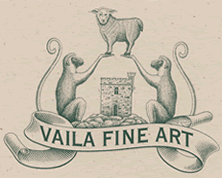Paul Bloomer: Unseen
From 16 April 2011
Pricing
All works available for sale.
Artists statement. Paul Bloomer: Unseen
When Dorota searched through the creative chaos of my studio to select work for this show her eyes alighted on a pile of experimental watercolours on Japanese paper and a pile of forgotten, neglected, unprinted and mostly unseen woodcut blocks.
When I looked at these paintings and prints side by side I realized that in different ways they are a both fusion of German and Japanese influences that I have internalized over many years.
I first started making woodcut prints 25 years ago, inspired in part by German Expressionism. Expressionism is built around the direct spontaneous unadulterated expression of emotion and was the perfect outlet for my urban angst of the time. When I arrived in Shetland in 1997 I found myself in paradise, but the lack of uprights in the Shetland landscape forced me to look for new shapes to build my compositions around. Birds and fish in a celebration of freedom and life replaced the smoking factory chimneys and despairing fighters. Almost overnight the aggression of German Expressionist inspired prints was replaced by the peaceful harmony that is found in Japanese woodcuts.
The search for purer and brighter colour in painting has always been my love but in The Black Country of my youth colour evaded me. My first studio a disused telephone on the West side of Shetland had little natural light so again colour evaded me and woodcut became once again a major form of expression as I worked through the night for five years.
A move to Bigton in 2002 saw two decades of repressed colour explode on to canvas and paper as I made the most of a light filled studio and the spectacular light filled landscape of the South Mainland. The woodcuts got buried deeper in my studio remaining unprinted, unseen and forgotten about until Dorota drew my attention to them again. Printing them was a great revelation and has reignited my love of the technique.
The watercolours in this exhibition are also a fusion of German and Japanese influence. The luminous watercolours of the German painter Emil Nolde had for many years remained a technical mystery to me because most of the texts about his work were in German. A recent publication in English had a section written by his son called ‘watching him paint’ explaining Nolde’s approach to watercolour that is rooted in the ancient techniques of Chinese and Japanese painting and calligraphy. Firstly he made up jars of ready mixed intense watercolour with a different brush for each colour that was arranged in careful order like the keyboard of a piano so when inspiration flowed he hardly had to think about what he was doing.
I differ from Nolde in that I prefer to make my own watercolours from pure pigment suspended in gum Arabic solution that like him I keep mixed in a jar. There is nothing delicate about this paint but it suits my purposes because it is loaded with as much pigment as possible.
Secondly and most importantly he painted on highly absorbent very strong Japanese paper. This paper acts like a sponge that pulls the pigment deep into its structure demanding repeated applications of paint. I realized this is not for the faint hearted because it sometimes takes a dozen applications of paint to get the desired intensity of colour that can be difficult to control, but the result is an intense build up of pigment that is not just floating transparently on the surface of the paper as in traditional western watercolours but is deeply absorbed in the long strong fibre of the paper as it is in traditional Chinese and Japanese calligraphy and painting.
Printmaking came before painting for me and the sometimes graphic nature of my oils and acrylics stems directly from my woodcuts. However the watercolours and pastels are from an entirely different root in that they are painted in direct response to nature with no preconceived ideas, only a battle to turn some of the raw elemental energy of the Shetland landscape into pure bright colour.
I hope this exhibition is as much of a pleasant surprise for you as it is for me and thanks go to Dorota for giving the opportunity to show works that were almost certainly destined to remain unseen.
Paul Bloomer, Bigton, March 2011
